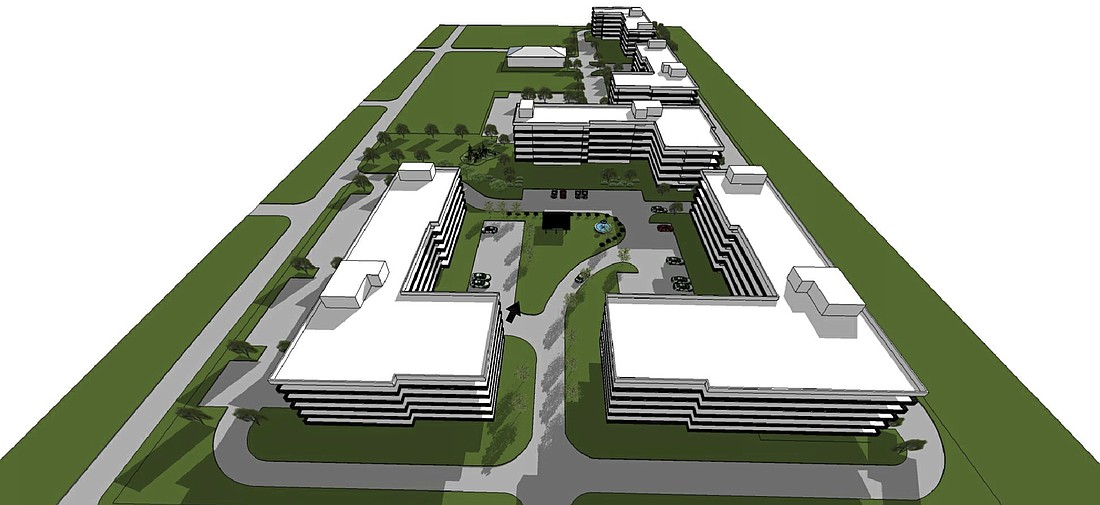- April 26, 2024
-
-
Loading

Loading

In making the case for a proposed 404-unit apartment development at 2211 Fruitville Road, Joe Barnette, planning representative, tried to sum up his argument simply: Sarasota needs affordable housing badly, and nobody else is stepping up to provide it.
“There are no alternatives,” Barnette said. ‘There's none — zip. This is a ready-to-go project.”
Barnette represented entrepreneur Harvey Vengroff at a public workshop Monday, the first step toward realizing Vengroff’s plans for an affordable housing complex on more than eight acres of downtown-adjacent land. Those plans have been in the works for more than a decade, and although they’ve been scaled down from an original vision of as many as 800 units, Vengroff is determined to make it a reality.
The road to constructing those houses will not be easy. Monday’s workshop was designed to introduce the public to a project that would require a comprehensive plan amendment, rezone and alley vacation before work could begin. Vengroff wants the property reclassified as Downtown Core — increasing the allowed density and height of a proposed project on the site.
Residents at Monday’s meeting had a variety of questions about the project — about the definition of “affordable housing,” about the impact on the surrounding neighborhood, about the management of the apartment complex. Still, a number of people in attendance also spoke in favor of the project, arguing the city was desperately lacking affordable housing and couldn’t afford to reject a wholly private plan seeking to fill that void.
One unknown that remained unaddressed — and that may be crucial as officials consider whether to allow Vengroff to proceed with his plans — is the degree to which the city can be assured the affordable units will come to fruition and remain affordable for the foreseeable future.
Commissioner Susan Chapman has harped on the need to create more affordable housing in the city and bemoaned the elimination of affordable or attainable elements in recent developments. Although she declined to comment on the specifics of Vengroff’s proposal, she suggested a degree of skepticism would be healthy when evaluating it.
“All I know is, over the years, we've seen a lot of claims that there's going to be a project that's affordable,” Chapman said.
Ethan Frizzell, the head of The Salvation Army Sarasota, is a supporter of Vengroff’s proposal, but shared similar concerns. He suggested there might be a way to hammer down a plan for the rents over a five-to-seven-year period to ease the minds of policymakers when they consider the requested changes.
Vengroff has bemoaned government hurdles as he’s tried to get this proposal into place, but Frizzell said the project requires a significant investment from the city, even if no money is involved.
“All the cash may be on your side, but there is a whole lot of public trust that is being asked for,” Frizzell said. “I believe that it's necessary in order to let developers build — otherwise, we won't get affordable housing in the mix.”
The 404 units would be a mix of apartments, ranging from studios to three bedrooms. The size of those apartments would be between 350 square feet and 842 square feet, with monthyl rents between $600 and $950. The apartments would be located in five separate six-story buildings on the property.
Vengroff would also need the city to sign off on less stringent parking requirements for his project. Instead of providing one parking space per residence, the plans call for just 242 parking spaces. Based on the market these apartments are targeted toward, Barnette said many of the tenants will not have cars of their own. Furthermore, he said, adding more parking would make the development of small, less expensive apartment units unfeasible.
Basically, Barnette explained, they had to choose between keeping prices lower or adding more parking.
“I don't meant to be cavalier about the parking,” Barnette said. “But it sort of comes down to that's what we have to work with.”
With some specifics unavailable at this point in the planning process, Vengroff heavily leaned on his personal experience in the area. Vengroff owns nearly 1,500 residential units in the region, and has sought to target lower-income tenants.
"I do have an expiration date, but I also have five kids that are at least a generation younger than me. They want to keep doing the same thing we’re doing." — Harvey Vengroff
He argued that the potential downside of moving forward with the project — more market-rate apartments near downtown — didn’t justify turning down the opportunity for affordable housing. He acknowledged that there were no measures in place to ensure affordability in perpetuity, but said he was committed to following through on his goal.
“I’m not sure that you can ever guarantee that — I do have an expiration date — but I also have five kids that are at least a generation younger than me,” Vengroff said. “They want to keep doing the same thing we’re doing.”
Although the required changes would necessitate state review and City Commission approval, Barnette attempted to argue that the city and residents shouldn’t be too picky when considering the proposal — even if some questions lingered.
“There has to be a little bit of faith here on this project,” Barnette said. “Is anything in life that certain? No, it's not.”